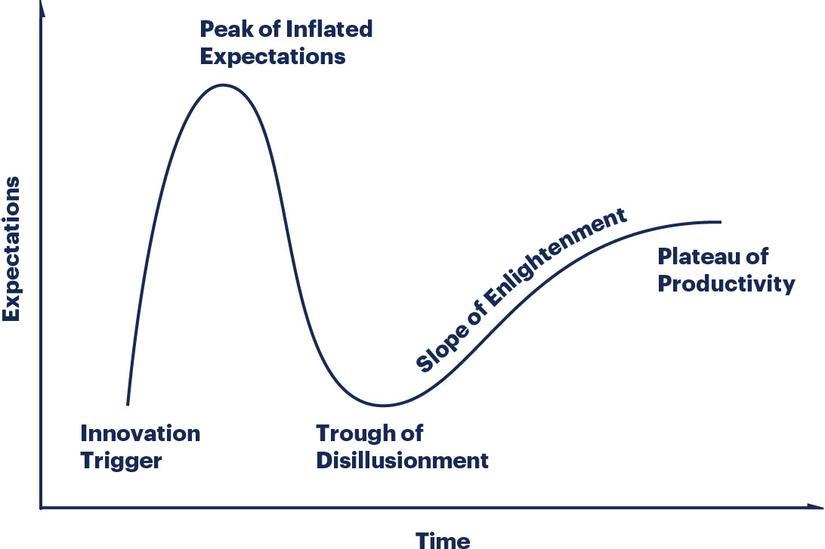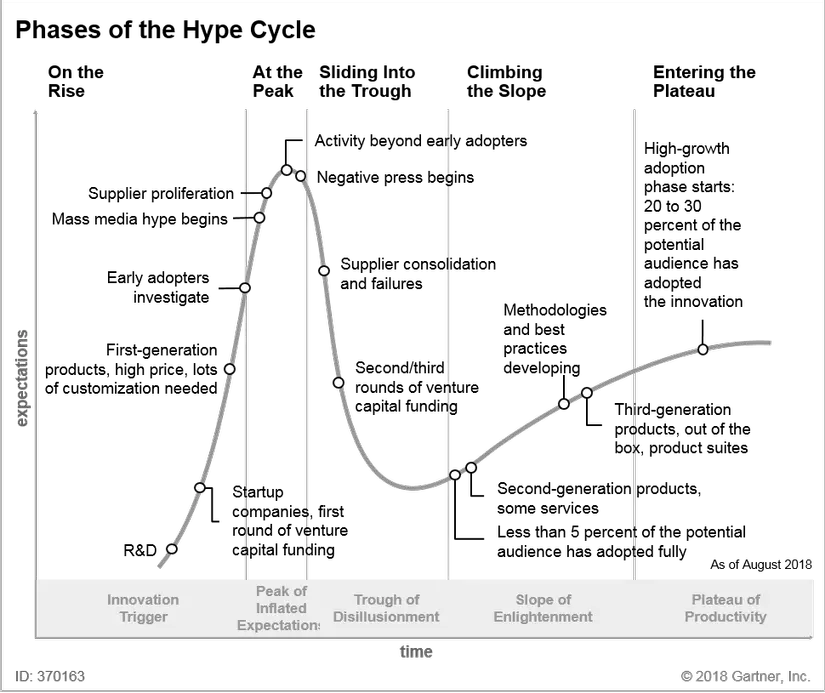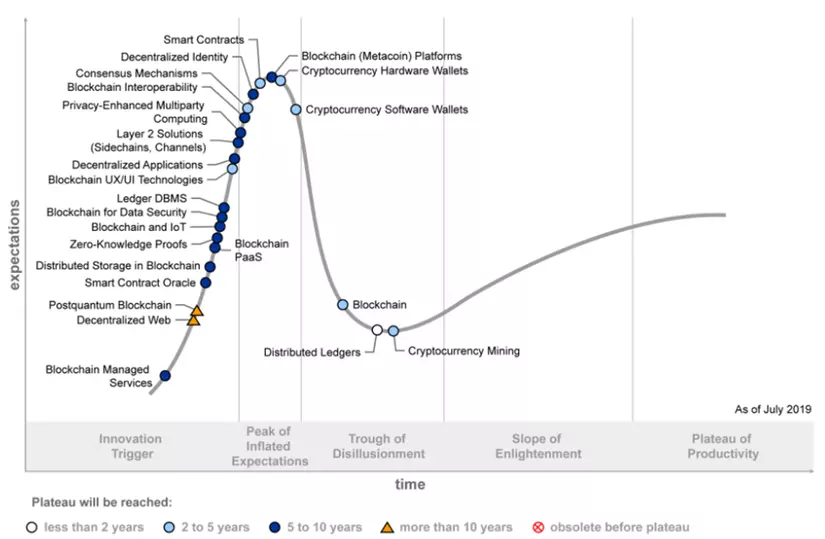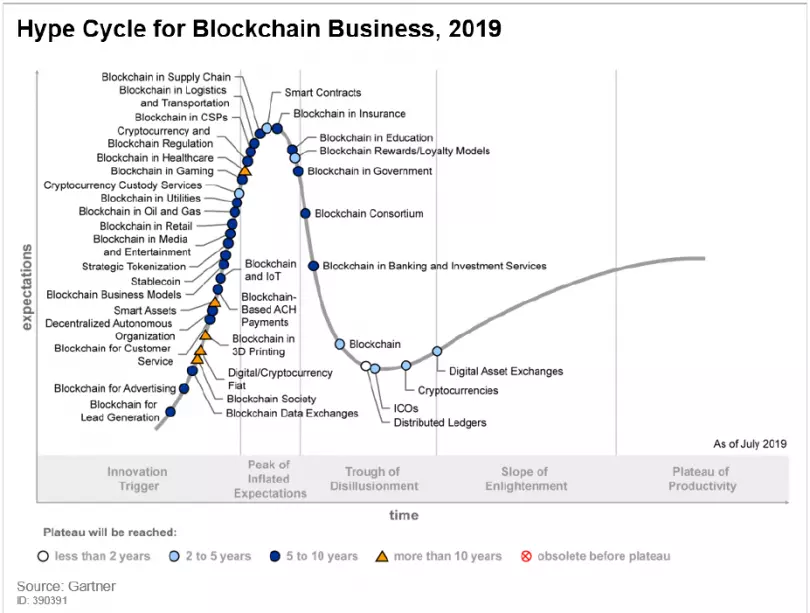What is the Hype Cycle?
Hype Cycle is a concept initiated by Gartner, a well-known American market research firm.
The Hype Cycle provides an overall picture of the shift in emerging trends across a wide range of areas, from appearance until these trends / technologies are applied to life.

Through the Hype Cycle, we can capture the need and potential of technologies, thus making more accurate decisions for our businesses.
Should we get in early? Are the current options appropriate? Should we wait for more tests?
It can be said that for developers, technology managers, researchers … this is a report not to be missed.
Many places translate it into an “expectation cycle”, but I don’t like this translation very much, and I find it is not very literal, so I will temporarily translate it as
chu kỳ bong bóng.
How does the Hype Cycle work?
In Hype Cycle , we have 5 stages:

- Innovation Trigger (dawn Technology): A potential new technology introduction, appeared theories and products proof-of-concept. However, usually no products will be used and its commerciality has not been proven.
- Peak of Inflated Expectations (peak of inflated expectations): Appeared a few stories about the first successful product, it comes with numerous other failures. Some companies act, most do not.
- Trough of Disillusionment ( bottom of disillusionment ): Initial experiments and implementations are almost impossible to produce a satisfactory result. Technology manufacturers are in a crisis of failure. Investments are only poured in when suppliers upgrade their products enough to be able to hit the market soon.
- Slope of Enlightenment ( slope of enlightenment ): More and more evidences for the ability of technology to be successful and widely applied. The second generation, third generation, .. of technology appeared. More investors have joined in, but the conservative companies remain cautious.
- Plateau of Productivity (plateau of productivity): Become a mainstream technology. Evaluation criteria and guidelines are completed. The applicability in the market has been expanded, bringing clear profits.
What does the Hype Cycle help us?
- Recognize the excessive hype from the commercial promises of new technologies.
- Minimize the risk of technology investment decisions.
- Compare our own assessments of the commercial value of technology with objective reviews from IT analysts.
Where are we in the bubble cycle?
Gartner provides us with a lot of reports about many different types of technology, but here I want to talk specifically about the two technologies that in recent years have been very popular in the world in general and in Vietnam in particular. Blockchain and AI.
In recent years, it can be said that people talking about AI, home talking about Bitcoin, everywhere have seen the phrase “industrial revolution 4.0”. 
If someone had a chance to listen to ideas presented at hackathon or ideathon contests or simply listen to graduate security protests at university, then one thing would be that more than half of the ideas were build AI systems. Like there is a lot of data, we will put it through AI, and it will give us the results we want. How magical!
So, back to reality, where are we in this cycle? Are we going to be late on train 4.0? Or are we rushing to the top of the hype?
Let’s go!
Blockchain
In terms of technology

It is evident that most of the related technologies in blockchain are at the dawn of technology and are overblown for its capabilities.
And what is hype earliest, perhaps we all know, that Bitcoin is dispersed Ledger (Distributed Ledger), Dao coin (Cryptocurrencies Mining).
There was a time in 2017 when everyone rushed into Bitcoin and virtual money, miners, miners.
Through 2018, that market began to decline from its peak, gradually moving towards its real value, Bitcoin plummeted, sell-off miners, the collapse of ICOs, the volatility of the virtual currency market together. scam has made not so many people interested in virtual money in particular and blockchain in general.
For at least the next few years, it will be quite difficult to get truly significant achievements with blockchain, as the technology is still in the process of being finalized and is still on the edge of the hype of expectations.
But in essence, the potential of technology is still great, just that we need more time to research and develop, turn it into a mainstream technology only.
In terms of business

In a survey for CIOs of major technology firms, the results showed that “Although blockchain technology is still not clear for their business model, 60% of CIOs expect that they will be able to apply blockchain. in the next 3 years “.
Looking at the chart, we can see that blockchain is getting into many industries today. These include insurance, finance and banking, healthcare, logistics, supply chains, oil and gas, games …
Finance and banking
It can be said that the banking system is the most powerful place of digital transformation. And blockchain has a very consistent architecture with core elements in this industry, especially permissioned ledgers .
18% of CIOs said they would apply blockchain within 12 months, and 15% would apply within the next 2 years.
Gaming
Games have always been a very lucrative field for developers.
While the current blockchain technology is not designed for game development, we can see the very appropriate elements here such as token system, digital asset system . If these systems are complete, it is possible to have universal games, where the characters and items of this game can be used – sold – on other games, or even non-trading platforms. concentrate.
Retail and supply chain
Many big companies, especially IBM and Intel, are investing heavily in both hardware and software to develop supply chains today. If successful, the demand for these supply chain products will be truly huge.
In short, we can totally trust the development of blockchain in the coming years.
WHO

AI – which has a long history of development, but the theory of AI has preceded the development of hardware too far, so until recently we have achieved achievements that can be considered significant. thanks to the development of computer hardware.
In recent years, new theories about Deep Learning, classic machine learning models, and a series of AI products have been born that have brought great buzz to this science. A series of events such as “AI defeats humans” in subjects such as Go, chess, or recently Dota has shown us that great progress.
A lot of big companies like Google, Microsoft, Facebook have put millions of dollars into research and development.
Companies boldly spend a lot of money to recruit AI talent to work for them.
AI Lab appears at almost every university in the world. AI Everywhere!
But, looking at it also has to look back, it is clear that super hot technologies like Machine Learning , Deep Learning , Auto ML are at the peak of the hype of expectation.
Then it will be time for us to stop and ask questions:
“When AI regress, Deep Learning regress, do we still research / do AI again?”
The good news is that there are products of AI that have really become completed and put into mainstream production, those are Speech Recognition products – the closest and most recognizable speech recognition that we see. Virtual assistants like Siri, Cortana, Google Assistant . Today we can see it everywhere on the internet, on phones, on televisions, and on other smart devices.
And like Blockchain, many of the other potential technologies in this area are still at the technological dawn and have yet to take shape.
We still have many opportunities to research and develop those technologies in the future.
We will try to take a look at some hot things in AI:
Augmented intelligence (enhanced intelligence)
This AI system will help enhance the efficiency of human work through interaction and automation with AI. Can be considered as an AI AI assistant.
But at the same time still subject to human control to avoid the risk of automatic decisions caused.
Chatbot
Perhaps not to talk much about chatbots anymore, this is also a very successful application of AI in general, and NLP or speech recognition in particular. Chatbots today are not just text chat, they have voice chatbots.
There are many well-known chatbot companies in their work, with common jobs such as HR, IT help desk, self-service, and especially customer service.
Certainly the chatbot market will be much more active in the coming years.
AI governance (AI administration)
In addition to developing AI systems, it is equally important to introduce theories and practices about AI governance.
It not only helps us avoid the legal risks of AI, but also avoids the negative, or unethical, applications that AI models can cause.
Now the most important factors in AI management are: trust, transparency, and diversity.
Intelligent applications
Businesses and organizations will prioritize integrating or embedding smart applications to replace people gradually, while improving performance and decision-making capabilities through the vast amount of data collected.
Smart applications can engage in a variety of steps from enterprise resource planning, to customer relationship management, to capital and human resource management, to productivity-boosting applications.
Conclude
Any technology before becoming a mainstream technology must undergo periods of exaggeration, periods of difficulty, but if its potential is large enough, it will still succeed in the future, even if there is maybe it will take time, sometimes 2 years, 3 years, or maybe 5-10 years.
As a technology person, choose your area of passion to pursue. Do not choose to follow the trend, we will soon be bored when technology is not as our expectations anymore.
And don’t forget to follow Gartner’s annual report to find out where we are in the bubble cycle 
High risk high return!
Refer
- https://www.gartner.com/en/research/methodologies/gartner-hype-cycle
- https://www.gartner.com/en/newsroom/press-releases 2019-10-08-gartner-2019-hype-cycle-shows-most-blockchain-technologies-are-still-five-to-10- years-away-from-transformational-impact
- https://www.gartner.com/smarterwithgartner/top-trends-on-the-gartner-hype-cycle-for-artificial-intelligence-2019
- https://pharmaphorum.com/views-analysis-digital/ai-in-the-gartner-hype-cycle/
- https://spiderum.com/bai-dang/P6-Hype-Cycle-Chu-ky-Ky-vong-cua-hang-Gartner-99i
- https://www.devpro.edu.vn/loi-di-nao-danh-cho-cac-chuyen-gia-va-ky-su-ai
- http://cusbe.tech/index.php/2017/09/14/chia-se-the-hype-cycle-of-emerging-technologies/
